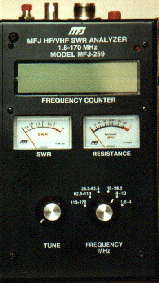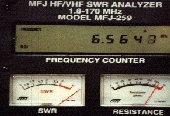



Anyone at all interested in antenna experimentation would appreciate a single unit that could do all of the following:
All the above and more can be done with the MFJ antenna analyzer model MFJ-259. Sounds like an advert doesn't it? Yet, I have connection with MFJ, just a satisfied customer!
It would seem at first that the unit is expensive,costing some £250 in UK, but taking into account what it can do, and what other pieces of gear it replaces, and conveniently at that, then the item becomes very desirable.
The 259 is portable, operating from internal AA batteries, or an external 12 volt nominal supply. The 259 does draw about 200mA, so dry batteries do not last long. In fact I usually use a 12 volt gel cell external to the 259.
Basically the 259 combines a wide range oscillator, a frequency counter, a 50 ohm RF bridge and a calibrated bridge unbalance indicator.
The frequency selector switch selects six frequency ranges, 1.8 - 4.0, 4.0 - 10.0, 10.0 - 26.2, 26.2 - 62.5, 62.5 - 113 and 113 - 170 MHz
I hope my scanned pictures will illustrate the controls of the 259. An SO259 socket on the top of the unit is used for connecting to antenna coax and a BNC socket is used for frequency measurement purposes. There are two red buttons on the top, one selects the input, i.e use as an antenna analyzer or frequency meter, and the other selects the accuracy of the readout (to seven decimal places!). So you can use this to set your VFO to 3.5602348 mHz if you want to!
RF from the 259 is modulated, which is indicated by an LED on the front panel.
In use, the unit is connected via a short length of coax to the feed point of the antenna, and the tuning control is adjusted until the lowest SWR is seen in the left hand meter. At the same time, the impedance is shown in the right hand meter. Adjustments can then be made to obtain the best match. In the case of a vertical for example, tapping points on a loading coil can be moved to obtain the best match, i.e 1:1 SWR and 50 ohms impedance. Tuning mobile whips, for example becomes an easy task. It may be worth pointing out that to be able to read impedance, SWR and frequency all at once is invaluable, which in my opinion is what the MFJ Antenna Analyzer is. It tells you just about all you need to know about your antenna.
Accompanying the MFJ259 is a comprehensive manual, illustrating how to use the unit for all the above purposes.
With an additional simple add-on, comprising a simple coil and a couple of capacitors, also turns the unit into an all frequency dip oscillator. All we need in one package. Either buy one or get to know someone who already has!
Frank G3YCC.